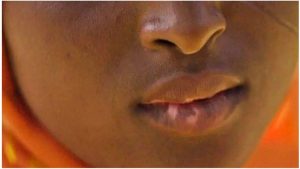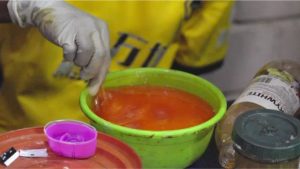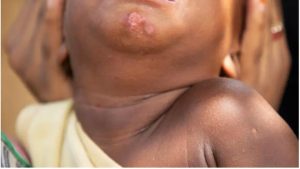AND GUESS which country is the WORST in this bleaching madness?
‘I scarred my six children by using skin-lightening creams’
A mother in northern Nigeria is visibly upset as she clutches her two-year-old child, who has burns and discoloured skin on his face and legs.



The 32-year-old used skin-whitening products on all six of her children, under pressure from her family, with results that she now deeply regrets.
Fatima, whose name has been changed to protect her family’s identity, says one of her daughters covers her face whenever she goes out in order to hide her burns.
al mixing bleaching creams in the market
Another was left with darker skin than before – with a pale circle around her eyes, while a third has whitish scars on her lips and knees.
Her toddler still has weeping wounds – his skin is taking a long time to heal.
“My sister gave birth to light-skinned children but my children are darker skinned. I noticed that my mother favours my sister’s children over mine due to their skin tone and it hurt my feelings a lot,” Fatima says.
She says she used creams she bought at her local supermarket in the city of Kano, without a doctor’s prescription.
At first it seemed to work. The grandmother warmed towards Fatima’s children, who were aged between two and 16 at the time.
But then the burns and scars appeared.
Skin-whitening or lightening, also known as bleaching in Nigeria, is used in different parts of the world for cosmetic reasons, though these often have deep cultural roots.
Women in Nigeria use skin-whitening products more than in any other African country – 77% use them regularly, according to the UN World Health Organization (WHO).
The creams may contain corticosteroids or hydroquinone, which can be harmful if used in high quantities, and in many countries are only obtainable with a doctor’s prescription.
Other ingredients sometimes used are the poisonous metal, mercury, and kojic acid – a by-product from the manufacture of the Japanese alcoholic drink, sake.
Dermatitis, acne and skin discolouration are possible consequences, but also inflammatory disorders, mercury poisoning and kidney damage.
The skin may become thinner, with the result that wounds take longer to heal, and are more likely to become infected, the WHO says.
”I visited a popular market in Kano, where people who call themselves “mixologists” create skin-whitening creams from scratch.
The market has a whole row of shops where thousands of these creams are sold.
Some pre-mixed varieties are arranged on shelves, but customers can also select raw ingredients and ask for the cream to be mixed in front of them.
I noticed that many bleaching creams, with labels saying they were for babies, contained regulated substances.
Other sellers admitted using regulated ingredients such as kojic acid, hydroquinone and a powerful antioxidant, glutathione, which may cause rashes and other side-effects.
I also witnessed teenage girls buying bleaching creams for themselves and in bulk so that they could sell them to their peers….’


